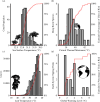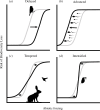Clustered warming tolerances and the nonlinear risks of biodiversity loss on a warming planet
- PMID: 39780588
- PMCID: PMC11720646
- DOI: 10.1098/rstb.2023.0321
Clustered warming tolerances and the nonlinear risks of biodiversity loss on a warming planet
Abstract
Anthropogenic climate change is projected to become a major driver of biodiversity loss, destabilizing the ecosystems on which human society depends. As the planet rapidly warms, the disruption of ecological interactions among populations, species and their environment, will likely drive positive feedback loops, accelerating the pace and magnitude of biodiversity losses. We propose that, even without invoking such amplifying feedback, biodiversity loss should increase nonlinearly with warming because of the non-uniform distribution of biodiversity. Whether these non-uniformities are the uneven distribution of populations across a species' thermal niche, or the uneven distribution of thermal niche limits among species within an ecological community, we show that in both cases, the resulting clustering in population warming tolerances drives nonlinear increases in the risk to biodiversity. We discuss how fundamental constraints on species' physiologies and geographical distributions give rise to clustered warming tolerances, and how population responses to changing climates could variously temper, delay or intensify nonlinear dynamics. We argue that nonlinear increases in risks to biodiversity should be the null expectation under warming, and highlight the empirical research needed to understand the causes, commonness and consequences of clustered warming tolerances to better predict where, when and why nonlinear biodiversity losses will occur.This article is part of the discussion meeting issue 'Bending the curve towards nature recovery: building on Georgina Mace's legacy for a biodiverse future'.
Keywords: biodiversity loss; climate change; global change; thermal limit; thermal safety margin; tipping point.
Conflict of interest statement
We declare we have no competing interests.
Figures




Similar articles
-
Impacts of limits to adaptation on population and community persistence in a changing environment.Philos Trans R Soc Lond B Biol Sci. 2025 Jan 9;380(1917):20230322. doi: 10.1098/rstb.2023.0322. Epub 2025 Jan 9. Philos Trans R Soc Lond B Biol Sci. 2025. PMID: 39780591 Free PMC article. Review.
-
How should we bend the curve of biodiversity loss to build a just and sustainable future?Philos Trans R Soc Lond B Biol Sci. 2025 Jan 9;380(1917):20230205. doi: 10.1098/rstb.2023.0205. Epub 2025 Jan 9. Philos Trans R Soc Lond B Biol Sci. 2025. PMID: 39780603 Free PMC article.
-
Bending the curve of biodiversity loss requires a 'satnav' for nature.Philos Trans R Soc Lond B Biol Sci. 2025 Jan 9;380(1917):20230210. doi: 10.1098/rstb.2023.0210. Epub 2025 Jan 9. Philos Trans R Soc Lond B Biol Sci. 2025. PMID: 39780594 Free PMC article.
-
Towards a 'people and nature' paradigm for biodiversity and infectious disease.Philos Trans R Soc Lond B Biol Sci. 2025 Jan 9;380(1917):20230259. doi: 10.1098/rstb.2023.0259. Epub 2025 Jan 9. Philos Trans R Soc Lond B Biol Sci. 2025. PMID: 39780600 Free PMC article. Review.
-
Temperature-dependent dispersal and ectotherm species' distributions in a warming world.J Anim Ecol. 2024 Apr;93(4):428-446. doi: 10.1111/1365-2656.14054. Epub 2024 Feb 26. J Anim Ecol. 2024. PMID: 38406823
Cited by
-
Impacts of limits to adaptation on population and community persistence in a changing environment.Philos Trans R Soc Lond B Biol Sci. 2025 Jan 9;380(1917):20230322. doi: 10.1098/rstb.2023.0322. Epub 2025 Jan 9. Philos Trans R Soc Lond B Biol Sci. 2025. PMID: 39780591 Free PMC article. Review.
-
How should we bend the curve of biodiversity loss to build a just and sustainable future?Philos Trans R Soc Lond B Biol Sci. 2025 Jan 9;380(1917):20230205. doi: 10.1098/rstb.2023.0205. Epub 2025 Jan 9. Philos Trans R Soc Lond B Biol Sci. 2025. PMID: 39780603 Free PMC article.
References
MeSH terms
Grants and funding
LinkOut - more resources
Full Text Sources
Research Materials

